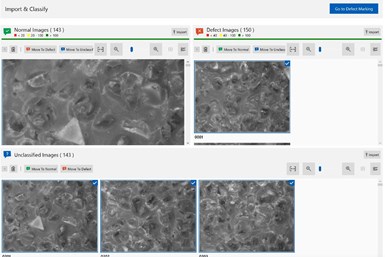Mitutoyo AI Inspect Uses AI-Enhanced Visual Defect Analysis
Mitutoyo’s AI Inspect program enables operators to leverage AI-enhanced modules for visual defect analysis.
Share






Mitutoyo America Corporation has added AI Inspect to its software lineup. Mitutoyo AI Inspect is a standalone software product designed to assist customers with next-generation visual defect analysis across multiple applications.
The software’s headlining features are the distinct Training Module and Runtime Module. The first of these enables users to develop inspection routines for automated implementation of defect detection using image sets, while the Runtime Module incorporates these inspection routines into the system.
The Training Module’s methodologies include importation, organization and storage of user-defined inspection projects; integrated tool sets and techniques for loading and classifying normal and defect image sets; an interface that enables the operator to mark and highlight defects on images; a section that enables operators to account for brightness, noise and focus differences; an interface that updates the operator on the progress and success of the training sequence; and an interface that allows operators to review image, pixel and component predictions. Users deploy models with unique identifiers for added clarity.
Mitutoyo AI Inspect’s Runtime Module includes an inference testing application for reviewing the AI model with sample testing on new images.
Related Content
-
Tips for Designing CNC Programs That Help Operators
The way a G-code program is formatted directly affects the productivity of the CNC people who use them. Design CNC programs that make CNC setup people and operators’ jobs easier.
-
How to Mitigate Chatter to Boost Machining Rates
There are usually better solutions to chatter than just reducing the feed rate. Through vibration analysis, the chatter problem can be solved, enabling much higher metal removal rates, better quality and longer tool life.
-
Orthopedic Event Discusses Manufacturing Strategies
At the seminar, representatives from multiple companies discussed strategies for making orthopedic devices accurately and efficiently.














